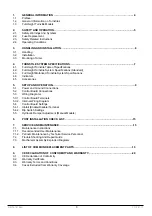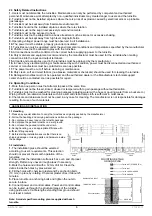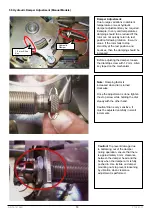
DD-75-181 R(2)
Y.T.13.07.17
8
4.2 Full- Height Turnstile System Specifications (Standard)
1.
System is designed for bi-directional operation. In standard models, when power is cut off, arms freewheel to allow
free passage in both directions; optionally the system can be set up to lock (fail-lock) when power is cut off.
2.
Mechanical parts of the turnstiles are made of stainless steel and galvanized metal. All locking mechanism
components are made of stainless steel.
3.
Once passage is permitted and arms rotate 30 degrees, arms will not return, and another passage is not allowed by
the system until the completion of the movement.
4.
After each complete passage the manual system returns to standby position smoothly and quietly by means of a
hydraulic shock absorber. Motor driven versions complete rotation by a light push following authorization.
5.
Signalization is provided with direction indicators placed on both sides of the upper body of the turnstile (While
green arrow indicates active passage direction, red bar shows the inhibited passage direction). In addition to the visual
signalization with green/ red indicators, an audio buzzer signal is provided during passage.
6.
Solenoids used within the system are driven by PWM for reliability, optimal energy efficiency and less heat. They do
not warm up to more than 10 degrees above the ambient temperature.
7.
Electronic board controlling the system is “coated inside the hole’ type” and therefore not affected by vibration.
8.
The micro-processor based electronic control system used in the turnstiles can be programmed for various
functions and operating modes by a simple dip switch selection.
9.
All inputs and outputs are isolated by opto-coupler and relay components for increased reliability.
10.
Turnstile passage directions can be inhibited (closed), set up for one way traffic or normal bi-directional operation
by enable/disable terminal located on the control board.
11.
The power supply is supported by “switching-mode” technology for better voltage regulation and energy efficiency.
12.
Turnstile only allows passages of authorized people. If a person does not pass within a pre-set time limit following
authorization contact (selectable for 6, 12, 18 or infinite seconds), the system automatically locks and returns to
standby.
13.
After each complete passage, the system provides dry contact relay output for each direction. An optional counter
can be used.
14.
Electronic control unit of the turnstile is protected against water for outdoor installations.
15.
Turnstiles can work in sync with door-type metal detectors; In security applications, even passage of a person with
authorization can be blocked automatically upon receiving contact from a metal detector. The system can be returned
to normal operation by the operator.
16.
In cases of emergency the turnstile can be switched into “emergency mode” with a normally closed manual button
or relay from fire alarm system. In emergency mode arms rotate freely in both directions allowing free passage.
17.
Turnstile passage directions can be arranged in different combinations by a dip switch on the control board. (For
example: one direction controlled other direction free; both directions controlled by separate readers, single reader for
both directions.)
18.
Turnstiles allow passage of only one person at a time for each authorization contact into the control board.
19.
Card readers or similar access control systems can be integrated into the turnstiles separately or jointly for
controlling both sides depending on the needs and specific requirements.
20.
Once a passage is completed, an entrance or exit direction data (dry contact) is provided to the data collection
terminal.
4.3 Full Height Motorized Turnstile System Specifications
1.
Microprocessor controlled bi-directional sytem incorporates an efficient PWM driven DC motor.
2.
Upon passage authorization received by the control board, system activates the motor following a light push on
the rotor and completes the rotation of 90° or 120° depending on the model. The rotor stops and tries to continue its
rotation once more if it meets an obstacle during its movement. If the obstacle is still present the rotor stops an alarm
is activated.
4.
Following a complete passage (90° or 120° rotation) turnstile locks and becomes ready for the next passage.
5.
Emergency mode:
Controlled by a
normally closed
(NC) button or fire alarm system contact. Turnstile will rotate
free in both directions as long as the emg contact remains open. Upon re-establishment of emg contact, turnstile
returns to normal operation mode.
RED X: Passage way closed (see 5.2’)
GREEN ARROW: Passage way open.
Buzzer is heard when a passage is authorized.
In alarm mode the indicators alternately blink in red and green and buzzer is heard.
4.4 Indicators
The system features status indicators on both sides and a buzzer for user guidance.
























